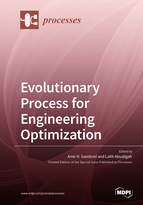Evolutionary Process for Engineering Optimization
A special issue of Processes (ISSN 2227-9717). This special issue belongs to the section "Process Control and Monitoring".
Deadline for manuscript submissions: closed (15 June 2022) | Viewed by 28729
Special Issue Editors
2. University Research and Innovation Center (EKIK), Óbuda University, 1034 Budapest, Hungary
Interests: data analytics; machine learning; evolutionary computation; engineering optimization
Special Issues, Collections and Topics in MDPI journals
Interests: arithmetic optimization algorithm (AOA); bio-inspired computing; nature-inspired computing; swarm intelligence; artificial intelligence; meta-heuristic modeling; optimization algorithms; evolutionary computations; information retrieval; text clustering; feature selection; combinatorial problems; optimization; advanced machine learning; big data; natural language processing
Special Issues, Collections and Topics in MDPI journals
Special Issue Information
Dear Colleagues,
Various real-world engineering applications, such as engineering design, industrial manufacturing systems, and water distribution networks, are complex problems. Evolutionary computation is a hot topic of interest amongst researchers in various disciplines of engineering and science. Evolutionary computation is a group of optimization algorithms used for solving global optimization problems, which is inspired by biological evolution. It includes various signal and population-based methods with a meta-heuristic or stochastic optimization part.
In recent years, evolutionary computation methods have been successfully utilized to address complex real-world problems. The literature is abundant with several other approaches that share the same goal: to find a new optimal solution with satisfactory quality by alternating search strategies. Many theoretical and experimental studies have proved significant evolutionary computation properties. The most famous evolutionary computation methods are the genetic algorithm (GA), evolution strategy (ES), differential evolution (DE), particle swarm optimization (PSO), bacterial foraging optimization (BFO), ant colony optimization (ACO), and the memetic algorithm (MA). However, with the fast growth of complex systems, the optimization problems become much larger and complicated. The common issues facing evolutionary algorithms are the dimension of objective functions, decision variables, or constraints.
In light of the expanding interest for new innovative methods of solving real-world and engineering optimization problems, this Special Issue intends to promote high-quality research outputs in the latest progress and improvement of evolutionary algorithms and engineering applications and offers recent advanced researches in the field to serve the researchers and practitioners. The main interest is on interdisciplinary research on te evolutionary algorithm, using modern computational intelligence theories, methods, and practices. We invite the researchers to submit their original contributions addressing particular challenging aspects in evolutionary computation from both theoretical and applied viewpoints. Authors are encouraged to submit their contributions covering the following topics:
Methods (but not be limited to):
Evolutionary computation
Swarm intelligence
Meta-heuristics
Genetic algorithm
Genetic programming
Differential evolution
Particle swarm optimization
Ant colony optimization
Bacterial foraging optimization
Applications (but not be limited to):
Material Optimization
Process Optimization
Engineering design problems
Complex system modelling and optimization
Constraint handling
Parameters tuning
Industrial problems
Benchmarks
Imaging and vision
Knowledge processing
Intelligent fault detection
Control and manufacturing applications
Multi/Many-objective optimization
Real-world applications for complex systems
Prof. Dr. Amir H. Gandomi
Dr. Laith Abualigah
Guest Editors
Manuscript Submission Information
Manuscripts should be submitted online at www.mdpi.com by registering and logging in to this website. Once you are registered, click here to go to the submission form. Manuscripts can be submitted until the deadline. All submissions that pass pre-check are peer-reviewed. Accepted papers will be published continuously in the journal (as soon as accepted) and will be listed together on the special issue website. Research articles, review articles as well as short communications are invited. For planned papers, a title and short abstract (about 100 words) can be sent to the Editorial Office for announcement on this website.
Submitted manuscripts should not have been published previously, nor be under consideration for publication elsewhere (except conference proceedings papers). All manuscripts are thoroughly refereed through a single-blind peer-review process. A guide for authors and other relevant information for submission of manuscripts is available on the Instructions for Authors page. Processes is an international peer-reviewed open access monthly journal published by MDPI.
Please visit the Instructions for Authors page before submitting a manuscript. The Article Processing Charge (APC) for publication in this open access journal is 2400 CHF (Swiss Francs). Submitted papers should be well formatted and use good English. Authors may use MDPI's English editing service prior to publication or during author revisions.
Keywords
- Evolutionary computation
- Swarm intelligence
- Meta-heuristics
- Genetic algorithm
- Genetic programming
- Differential evolution
- Particle swarm optimization
- Ant colony optimization
- Bacterial foraging optimization
- Material Optimization
- Process Optimization
- Engineering design problems
- Complex system modelling and optimization
- Constraint handling
- Parameters tuning
- Industrial problems
- Benchmarks
- Imaging and vision
- Knowledge processing
- Intelligent fault detection
- Control and manufacturing applications
- Multi/Many-objective optimization
- Real-world applications for complex systems







